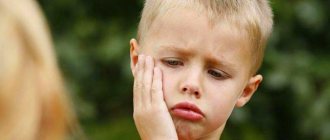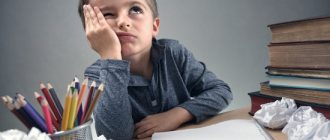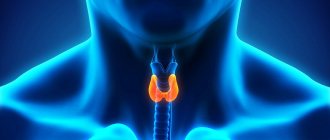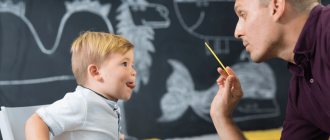Dyspraxia is a disorder of motor function and coordination of movements in a child with normal muscle tone. The deviation is associated with a violation of tactile sensations and movement planning. Often the pathology manifests itself from birth, although parents do not immediately notice it. The fact that a child has problems with articulatory motor skills is most often reported by a speech therapist after examining the child.
Experts first became aware of dyspraxia at the beginning of the last century. Initially it was called “clumsy child syndrome”, “sensory integration”, “developmental coordination disorder”, “developmental dyspraxia”. It is important not to confuse it with the term apraxia.
Main manifestations
Various degrees of dyspraxia are diagnosed in 3–6% of children, more often in boys. Many children are clumsy in early childhood, but a child with dyspraxia retains clumsiness even as an adult. Children who have been diagnosed with this disease find it difficult to perform everyday activities: they have difficulty speaking, often fall and stumble when walking, they have difficulty catching a ball in a game, maintaining balance when riding a bicycle, writing or reading something, etc. d.
Activities in which a child with dyspraxia has problems:
- speech – the work of the muscles of the articulatory apparatus is not coordinated, speech breathing is impaired;
- writing, drawing – difficulty holding a pen, brush, pencil, slow writing, long mastery of simple movements;
- reading - it is difficult to control eye movements and hold your gaze, which makes it difficult to follow the line with your eyes;
- performing basic movements when running, walking, jumping, maintaining balance;
- it is difficult to remember and reproduce the sequence of movements;
- games of high and medium mobility - children cannot catch and throw a ball, hold the attributes for the game, or use them.
Although modern medicine, and neuropathology in particular, is constantly developing innovative methods for preventing, treating and preventing disorders, dyspraxia in children is still an insufficiently studied problem.
Ways to restore speech after a stroke
Speech after a stroke is rehabilitated through a set of various measures. This includes taking medications that improve blood circulation and promotes the formation of new neural connections, and physical therapy, massage, speech therapy and articulation exercises, and much more. A plan for speech restoration after a stroke for a particular patient is developed individually based on research and the diagnosis made. Some aspects of rehabilitation therapy require specialist supervision, but not all of them. The patient can perform some exercises to restore speech after a stroke with the help and participation of people close to him, which will make the recovery process more effective.
As soon as the patient's condition has stabilized, the very first exercises begin. The patient is examined by a speech therapist and a neurologist. Special tests help identify existing problems and prescribe further treatment.
There are no guarantees that a person will fully restore speech skills: much depends on how severe the brain damage was, on the body’s ability to regenerate and the interest of the patient and his loved ones in achieving the goal.
It is strictly not recommended to self-medicate and teach the patient to talk on his own. There is a risk of developing complications in the form of echolalia - meaningless repetition of words, verbal embolus, agrammatism, etc. A set of treatment measures is prescribed exclusively by a group of treating specialists.
Speech therapy exercises
Regular sessions with a speech therapist are the key to speech restoration. At first, the specialist works with the patient himself, then relatives can continue training at home.
The basis of a speech therapist’s work is the involvement of certain parts of the brain in the control of speech functions. To do this, he uses different techniques and sets of exercises:
- Phonetic. Through the victim repeating individual sounds, words and phrases after the doctor, the type of speech disorder is determined. The facial muscles of the tongue and lips are under control.
- Semantic. The active thought process is stimulated. A person who has suffered a stroke must complete sentences, series of associations, and talk on various topics.
- Visual. The use of cards with images, book illustrations and other specialized items so that the patient begins to build various connections and associative series. This method is usually used for sensory aphasia.
- Creative. Various types of creative activities are included in the rehabilitation work, in particular those that the patient was interested in. This could be expressive reading of tongue twisters, poetry, acting, music, singing, drawing, etc.
There are several rules for completing tasks:
- Gradually increasing the complexity of the exercises;
- Encouragement of the patient's achievements is mandatory;
- Monitor the patient’s condition and prevent overwork;
- Number of classes – no more than 5-10 per week.
Based on the patient’s progress, the speech therapist should adjust the rehabilitation program from time to time.
Massage
After a stroke, there are often cases of not only speech impairment, but also the appearance of problems with the speech apparatus: in patients, chewing function is impaired, uncontrolled salivation appears, and the corners of the mouth and cheeks sag. There is a need to restore muscle tone and start the process of restoring correct facial expressions. Here a special massage comes to the aid of the patient, which is prescribed by the attending physician depending on the characteristics of the injury in a particular person.
The main objectives of massage within the framework of rehabilitation therapy are:
- Improving blood circulation and activating lymph outflow;
- Normalizing the tone and elasticity of muscle tissue;
- Strengthening the general condition of the body;
- Relieving tension and anxiety in patients.
Massage is prescribed almost immediately after the patient’s condition has stabilized: approximately one to two weeks after the crisis. At first, these are simple stroking of the muscles and gentle rubbing at a moderate rhythm. Then the techniques become more complex, kneading and vibration are used, the intensity and duration of the sessions increases.
The decision to prescribe or refuse massage courses is made by the attending physician. Sometimes a patient may have contraindications to it, an increased risk of developing severe deviations from the norm of body functionality, and other complications.
Articulation exercises
This type of exercise is used to increase control over the muscles involved in speaking.
Speech therapy exercises that develop language:
- Stick it out and hold it in this position for a few seconds;
- Try to reach your nose with your tongue and hold it;
- Pass it from one corner of the mouth to the other several times;
- Move your tongue back and forth across the palate;
- Clatter;
- Lightly bite your tongue after relaxing it;
- Trace your lips first counterclockwise and then clockwise.
Exercises to develop lips:
- Fold them into a tube and pull them out;
- Smile with your mouth closed;
- Raise your lip up, showing the upper row of teeth;
- Roll the air in different directions, inflating first one or the other cheek;
- Blow through your lips, having previously relaxed them;
- Use your fingers to pull them up, down, right, left;
- Alternate between raised and lowered corners of the mouth.
Exercises to restore your voice:
- Alternate pronunciation of vowels;
- Silent articulation of “Y”;
- Pronunciation of vowels one after another with a smooth transition of sound, while reversing stress;
- Repetition of consonant sounds - from voiceless to voiced.
Exercises for facial expressions:
- Working with eyebrows: frowning, being surprised with their help;
- Open very wide and then relax your mouth;
- “Kiss” the air;
- Stick your tongue out to your interlocutor and pull him in different directions;
- Move your jaw.
Depending on the type of disease, the doctor selects an individual set of tasks for each patient.
Breathing exercises
Classes with a speech therapist will be many times more effective if, before starting speech exercises, you perform physical exercises that will improve articulation and function of the facial muscles:
- Pull the letter “U” through the elongated “tube” lips;
- Smile several times so that symmetry is maintained at the corners of the lips;
- If the loss of sensitivity is insignificant, slightly bite the lower and then the upper lip;
- Roll up your tongue;
- Smack expressively;
- Run your tongue over your lips and palate;
- Calmly inflate and deflate your cheeks.
To achieve positive dynamics, exercises must be performed regularly.
Drug therapy
Taking medications in the post-stroke period allows you to prevent the process of cell destruction, normalize blood circulation and start the process of tissue regeneration.
Experts prescribe different types of drugs:
- Blood thinners – medications that reduce blood viscosity and stimulate improved blood circulation;
- Diuretics – relieve swelling, including in the brain;
- Nootropic drugs – stimulate the regeneration of nerve cells;
- Antihypertensive drugs – do not allow blood pressure to reach a critical value, which can cause complications.
Music therapy
In certain situations, when the patient does not speak at all, but can sing, treatment with music helps. All exercises with a speech therapist in such a situation involve singing: the patient sings sounds, words, sentences, repeats the words and motive after his favorite performer.
In addition, music has a positive effect on the human psyche, calming or making him happy. Often patients are in a state of depression or increased anxiety, and here music comes to the aid of specialists, which stabilizes the emotional background.
The positive effect of music on brain recovery after a stroke was studied in scientific workshops. During classes, people with speech impairments had their cerebral cortex activity measured. It has been proven that music stimulates the functioning of the nervous system, promotes the formation of new neural connections, and therefore restores brain properties lost during the disease.
Physiotherapy
A set of therapeutic practices and techniques for stimulating the articulatory apparatus and vocal cords by exposure to electrical impulses, magnetic radiation, light, heat or air, ultrasound, etc.
Some of the main goals of physiotherapy after a stroke are:
- Prevention of complications and new stroke;
- Improving blood circulation and metabolism;
- Preventing the occurrence of blood clots, which can lead to blockage of blood vessels;
- Restoration of muscle tone;
- Relieving pain and swelling;
- Improving the passage of nerve impulses, accelerating the formation of new neurons;
- Normalization of sleep patterns and general well-being of the patient.
Acupuncture
A popular procedure is used to correct motor aphasia and helps restore the tone of the speech apparatus.
The effectiveness of acupuncture has long been proven by science: needles irritate nerve endings in the skin, send signals to the brain and spinal cord, thereby activating the central nervous system and promoting the formation of new neurons. Also, when using this method, muscle activity improves, pain decreases, and the immune system is activated.
Traditional methods
Treatment of stroke with herbs is sometimes practiced by some doctors, prescribing it as an auxiliary therapy. Taking decoctions of viburnum, thyme, St. John's wort, rose hips, and calendula, of course, can help improve blood circulation or increase the body's overall resistance, but it is not a panacea.
We do not recommend starting treatment of relatives who have suffered from a stroke on their own using traditional methods: first consult with your doctor and make sure that the patient is not allergic to this or that drug.
Causes and symptoms of childhood dyspraxia
This disease can be either primary or secondary. In the first case, the causes of dyspraxia are not associated with neuropathological disorders, however, they are not easy to determine without the use of special techniques. In the second case, dyspraxia is a consequence of traumatic brain injury, cerebral palsy, other pathologies of the nervous system, or is part of the symptoms of Down syndrome, autism, and Williams syndrome.
Presumable causes of the pathology:
- Genetic predisposition - mutations of the FOXP2 gene.
- Family inheritance in a direct line, from parents.
- Pathological course of pregnancy - stressful situations, toxic effects of drugs, waste products of bacteria during viral infections, the environment, oxygen starvation of the fetus.
- Post-term or premature pregnancy.
The basis of the pathology, according to medical research, is not damage, but underdevelopment of connections between neurons. As a result, the nerve impulse arising in the cerebral cortex does not find its way to the motor system.
Symptoms of pathology may vary depending on the age of the child. In the first year of life, dyspraxia manifests itself in the form of disturbances in congenital reflexes:
- disturbances of the sucking reflex;
- problems with fixation of gaze;
- difficulty grasping objects with the palm of your hand;
- impaired coordination of movements.
In preschool age, there is increased motor activity, poor attention, difficulties with eating and maintaining balance.
Symptoms of the disorder are as follows:
- delayed development of the ability to eat and dress;
- awkwardness in movements;
- difficulty identifying the dominant hand;
- frequent falls and stumbles while walking;
- inability to catch and throw a ball, jump, stand on one leg, ride a bicycle;
- difficulties with learning to read and write;
- difficulty walking in a straight line;
- difficulty finding an answer to a simple question, although the child knows it;
- problems with long-term memory, when the child forgets the educational material studied the day before;
- inability to remember and follow complex instructions;
- difficulty determining the right and left sides;
- sleep disorders;
- sensitivity to touch.
Sometimes the pathology manifests itself only in high school age. Usually, this requires a strong emotional stimulus - excessive study load, negative attitude of peers or teachers.
In school-age children, pathology most often manifests itself in the inability to master the material. Dictations and copying are especially difficult. Children suffer from dysgraphia and dyscalculia.
All these symptoms leave an imprint on the psycho-emotional state of the child. He is unable to realize his potential because he is constantly the target of ridicule from his peers. Children become anxious, irritable, and passive. They move away from their peers and are often left alone.
Articulatory dyspraxia
Verbal (or articulatory) dyspraxia is a speech disorder, namely a violation of the pronunciation aspect of speech, which is associated with underdevelopment or incorrect formation of articulatory praxis. With such dyspraxia, the mobility and tone of the muscles and their contractile abilities are preserved.
Typically, this pathology is included by outdated sources in the range of speech therapy disorders - dysarthria.
The main differences between articulatory dyspraxia and dysarthria:
- if a word is familiar or automated, then it is likely to be pronounced correctly; but the same sounds in other words may be pronounced incorrectly (that is, the problem is not in the pronunciation of the sound as such, but in the formation of the pronunciation skill);
- the child independently searches for an articulatory position;
- the number of errors largely depends on the surrounding situation and the emotional state of the child (when repeating after a familiar adult in a calm state, the pronunciation will be correct; in a frightened or nervous state, errors are likely).
The main difficulties in verbal dyspraxia: distortion of sounds (their omission or replacement with others, rearrangement of syllables, etc.) and difficulties in constructing sentences.
Self-diagnosis methods
It is very important to promptly draw the attention of specialists to this problem, because in preschool age the development of movements and the development of the psyche are closely related to each other. A lag in any area entails a distorted development of other personality traits. It is important to arrive at the threshold of schooling with maximum compensation for dyspraxia.
There is a simple way to initially diagnose dyspraxia that can be done at home - the jump test. You need to jump on two legs, accompanied by the count “one-two-three-four”, changing the movements of the legs in a certain sequence:
- one - legs to the sides;
- two – legs crossed (left leg in front of right);
- three – legs to the sides;
- four - legs crossed (right leg in front of left).
Signs of trouble:
- the child cannot jump according to the pattern suggested by the adult;
- he is unable to maintain the rhythm set by the score;
- crossing his legs, he turns his pelvis.
This diagnostic method is quite accurate and can be used from 4–5 years of age.
Professional help
If you suspect dyspraxia, you need to conduct an examination to clarify the diagnosis and find out the reasons for its development. The help of professionals will depend on the functions of the child most affected by the disease.
Thinking
If mental activity is impaired, a child psychologist will provide assistance. It will help the child systematize and organize his thinking. Thanks to the help of this specialist, the child will gain self-respect and confidence.
Speech
If you have a speech disorder, you will need the help of a speech therapist who will prevent deterioration and delay in speech.
Movements
Specialists help the child develop various complex movements, breaking them down into separate mini-movements and combining them later.
Treatment methods
To correct dyspraxia, modern innovative techniques using kinesiotherapy are used:
- stabilometry method with bioactive connection;
- dynamic correction with reflex-loading devices “Gravistat”, “Adelie”, “Graviton”;
- passive vestibular training using a computer stand;
- electrical stimulation of muscles;
- computer video analysis of movements;
- transcranial polarization of the brain.
Simultaneously with similar methods, pharmacological therapy with cerebroprotectors of nootropic action is used: Cytoflavin, Actovegin, Cortexin, Lecithin, Glycine, Semax, Gliatilin.
General therapeutic measures are highly effective - physical therapy, psychological and speech therapy correction. Much attention is paid to restoring the function of balance and basic movements, for which mobile and finger games and elements of sports games are used.
When treating verbal dyspraxia, the speech therapist chooses a special system of exercises for the child, one part of which is aimed at developing the pronunciation of sounds, and the second at restoring articulation.
- The first option involves teaching the child accurate articulation of phonemes. Much attention is paid to sound patterns.
- The essence of the second option is to actively train the facial muscles responsible for articulation. At the beginning of therapy, the baby imitates the elementary movements of the lips and tongue, the description of which is wrapped in a fairy tale plot (“The Tale of the Merry Tongue”). Upon completion of the correction, he must independently reproduce a sequence of several movements.
Children with dyspraxia are encouraged to participate in group gymnastics classes. They perfectly develop the vestibular apparatus, and the child gains control over his movements. Games with musical accompaniment are very useful. While playing them, children will feel the rhythm, which allows them to improve body control and coordination.







